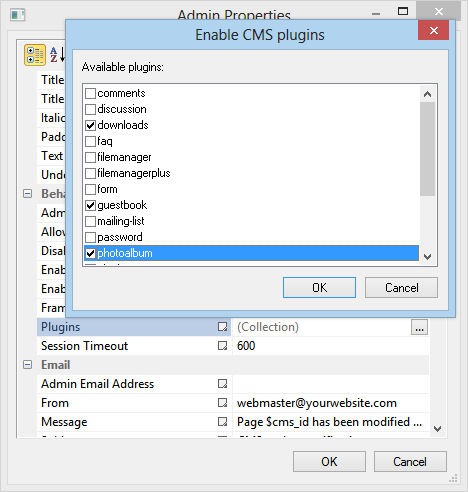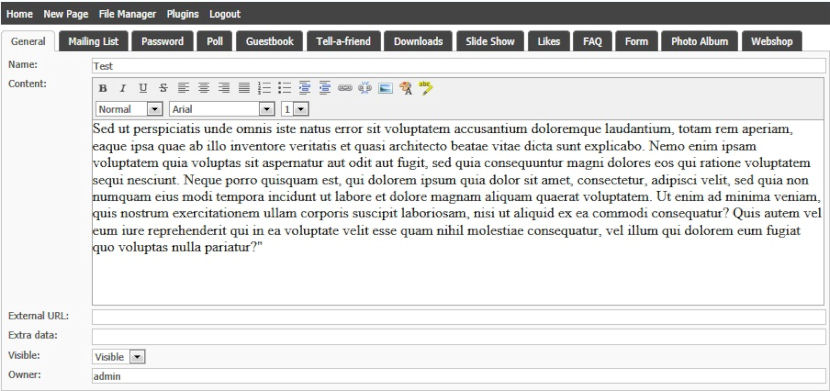
The Ultimate Toolbox for creating
amazing web sites!
Using CMS plug-ins
This is a list of plug-ins that are current available:
User Manager plug-in
Add/Edit/Remove users online. This makes it possible to manage users without the need to integrate with WWB’s login tools. Added users will be able to add or edit their own pages.
Comments plug-in
Adds the ability to post comments on a page.
Discussion plug-in
The Discussion plug-in enables you to add comments functionality to the page.
Users can comment on the content of the page and other users will be able to post replies to the comment to start a discussion.
Downloads plug-in
Automatically creates a list of links from files in a folder.
FAQ plug-in
Create a simple Frequently Asked Questions (FAQ) page.
Password plug-in
Protect the CMS page with a password. This can be configured per page and each page can have its own password.
File Manager plug-in
Implements a basic file manager to upload files. The default folder is 'files' but you can change this by editing the plugin file (plugin.php).
Form plug-in
Dynamically create forms online. Supports basic form validation (based on the selected input type) and reCAPTCHA. Submitted data can be sent in email and/or stored in a database and exported to CSV later.
Guestbook plug-in
Basic guestbook that can be integrated in the CMS.
Mailing list plug-in
Collect and manage email addresses in a mailing list. Users can subscribe to the mailing list by submitting their email address in the standard form. A confirmation email is sent to verify the email address. The admin can send messages to the subscribed users.
Photo album plug-in
The Photo Album plug-in is a basic online photo album solution for the CMS. It will display images from a folder on the server.
Slideshow plug-in
The Slide Show plug-in adds a slideshow to the CMS page.
Plug-in Manager
The plug-in manager can be used to enable/disable CMS plug-ins online.
Poll plug-in
A simple poll plug-in.
Tell-a-friend plug-in
Adds a basic tell-a-friend form to the CMS page.
Additional plugins for the CMS will be published here:
http://www.wysiwygwebbuilder.com/free_extras.html
User Manager plug-in
Add/Edit/Remove users online. This makes it possible to manage users without the need to integrate with WWB’s login tools. Added users will be able to add or edit their own pages.
Comments plug-in
Adds the ability to post comments on a page.
Discussion plug-in
The Discussion plug-in enables you to add comments functionality to the page.
Users can comment on the content of the page and other users will be able to post replies to the comment to start a discussion.
Downloads plug-in
Automatically creates a list of links from files in a folder.
FAQ plug-in
Create a simple Frequently Asked Questions (FAQ) page.
Password plug-in
Protect the CMS page with a password. This can be configured per page and each page can have its own password.
File Manager plug-in
Implements a basic file manager to upload files. The default folder is 'files' but you can change this by editing the plugin file (plugin.php).
Form plug-in
Dynamically create forms online. Supports basic form validation (based on the selected input type) and reCAPTCHA. Submitted data can be sent in email and/or stored in a database and exported to CSV later.
Guestbook plug-in
Basic guestbook that can be integrated in the CMS.
Mailing list plug-in
Collect and manage email addresses in a mailing list. Users can subscribe to the mailing list by submitting their email address in the standard form. A confirmation email is sent to verify the email address. The admin can send messages to the subscribed users.
Photo album plug-in
The Photo Album plug-in is a basic online photo album solution for the CMS. It will display images from a folder on the server.
Slideshow plug-in
The Slide Show plug-in adds a slideshow to the CMS page.
Plug-in Manager
The plug-in manager can be used to enable/disable CMS plug-ins online.
Poll plug-in
A simple poll plug-in.
Tell-a-friend plug-in
Adds a basic tell-a-friend form to the CMS page.
Additional plugins for the CMS will be published here:
http://www.wysiwygwebbuilder.com/free_extras.html
Important
Before reading this tutorial make sure you understand the basic of the CMS tools:
Getting started with the Content Management System.
Before reading this tutorial make sure you understand the basic of the CMS tools:
Getting started with the Content Management System.
Plug-ins can add new functionality to the CMS. Most plug-ins add extra code after the page content. For example the 'Comments' plug-in adds the comments at the end of the page. The CMS will store the information for each page in a separate record in the database. This information may include a 'flag' whether or not the plug-in is enabled for the page or in case of the comments plug-in one of more items per page.
Plug-ins are basically just PHP scripts that are 'injected' into the page. If you have knowledge of PHP then you can modify these scripts or even create your own plug-ins! The scripts are located on your local drive in the My Documents\WYSIWYG Web Builder\system\plugins\ folder. Each plug in has its own folder which contains all the files that are needed to make the plug-in do its work.
Note that we do not provide support on modifying the script, but here's a tip if you want to change or translate the text of a plug in:
open the plugin.php file with a text editor (like notepad). Note that each plug in has a set of 'define' statements at the start of the script.
by editing these strings you can change the text used in the plug in.
Warning: do not change anything else unless you know what you are doing!
Plug-ins can be enabled through the 'plugins' property of the CMS Admin object. Enabled plug-ins will be uploaded to the server and placed in a sub folder (plugins) of the current folder. You can enable/disable plug-ins online with the plug-in manager or by renaming the folder name (insert an underscore in front of the folder name. For example rename filemanager to _filemanager). Or simply remove the entire folder from the server.
Plug-ins are basically just PHP scripts that are 'injected' into the page. If you have knowledge of PHP then you can modify these scripts or even create your own plug-ins! The scripts are located on your local drive in the My Documents\WYSIWYG Web Builder\system\plugins\ folder. Each plug in has its own folder which contains all the files that are needed to make the plug-in do its work.
Note that we do not provide support on modifying the script, but here's a tip if you want to change or translate the text of a plug in:
open the plugin.php file with a text editor (like notepad). Note that each plug in has a set of 'define' statements at the start of the script.
by editing these strings you can change the text used in the plug in.
Warning: do not change anything else unless you know what you are doing!
Plug-ins can be enabled through the 'plugins' property of the CMS Admin object. Enabled plug-ins will be uploaded to the server and placed in a sub folder (plugins) of the current folder. You can enable/disable plug-ins online with the plug-in manager or by renaming the folder name (insert an underscore in front of the folder name. For example rename filemanager to _filemanager). Or simply remove the entire folder from the server.
Finally here are some random facts about plug-ins:
• plug-ins are standard PHP scripts.
• plug-ins can be modified if you are familiar with PHP. For example you can translate or modify the text display by the plug-ins.
• plug-ins are loaded by the CMS View and CMS Admin.
• most plug-ins have a 'view' part and an 'admin' part. The 'view' part will be loaded by CMS view. The code of the plug-in will be 'injected' at the end of the content.
• the 'admin' part will be loaded by the CMS Admin and display a configuration tab.
• each plug-in will generate its own table in the MySQL database for configuration and other data storage.
• most plug-ins will use the default styling as configured in the 'CMS View'
• plug-ins are locally stored in the folder My Documents\WYSIWYG Web Builder\system\plugins\
• plug-ins are published in a sub folder 'plugins' on the server. Each plug-in has its own folder.
• plug-ins are standard PHP scripts.
• plug-ins can be modified if you are familiar with PHP. For example you can translate or modify the text display by the plug-ins.
• plug-ins are loaded by the CMS View and CMS Admin.
• most plug-ins have a 'view' part and an 'admin' part. The 'view' part will be loaded by CMS view. The code of the plug-in will be 'injected' at the end of the content.
• the 'admin' part will be loaded by the CMS Admin and display a configuration tab.
• each plug-in will generate its own table in the MySQL database for configuration and other data storage.
• most plug-ins will use the default styling as configured in the 'CMS View'
• plug-ins are locally stored in the folder My Documents\WYSIWYG Web Builder\system\plugins\
• plug-ins are published in a sub folder 'plugins' on the server. Each plug-in has its own folder.


Notes:
Each plug-in will automatically generate one or more database tables on the MySQL server! Tables will not be removed when you remove the plug-in!
The generated tables contain the plug-in configuration and other data (for example the guestbook plug-in will store messages).
So you should only install the plug-ins you actually need otherwise you will end up with a lot of (unused) database tables.
Only publish the plug-ins that you really need because all plug-ins will be loaded/processed by all pages even if they are not enabled for the page. So having too much plug-ins on the server may slow down the performance of the CMS.
Each plug-in will automatically generate one or more database tables on the MySQL server! Tables will not be removed when you remove the plug-in!
The generated tables contain the plug-in configuration and other data (for example the guestbook plug-in will store messages).
So you should only install the plug-ins you actually need otherwise you will end up with a lot of (unused) database tables.
Only publish the plug-ins that you really need because all plug-ins will be loaded/processed by all pages even if they are not enabled for the page. So having too much plug-ins on the server may slow down the performance of the CMS.
This is a screenshot of the online CMS Administrator tool with a 'few' plug-ins activated. As you can see each plug-in will get its own tab for configuration.